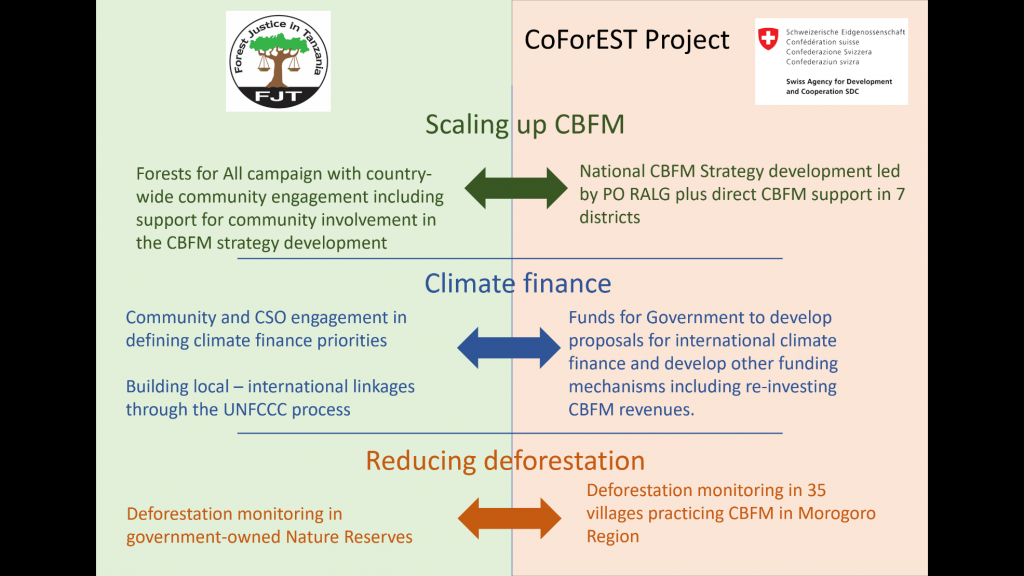Forest Justice in Tanzania (FJT) Phase 2 (2020-2021)
Overview of the FJT Project
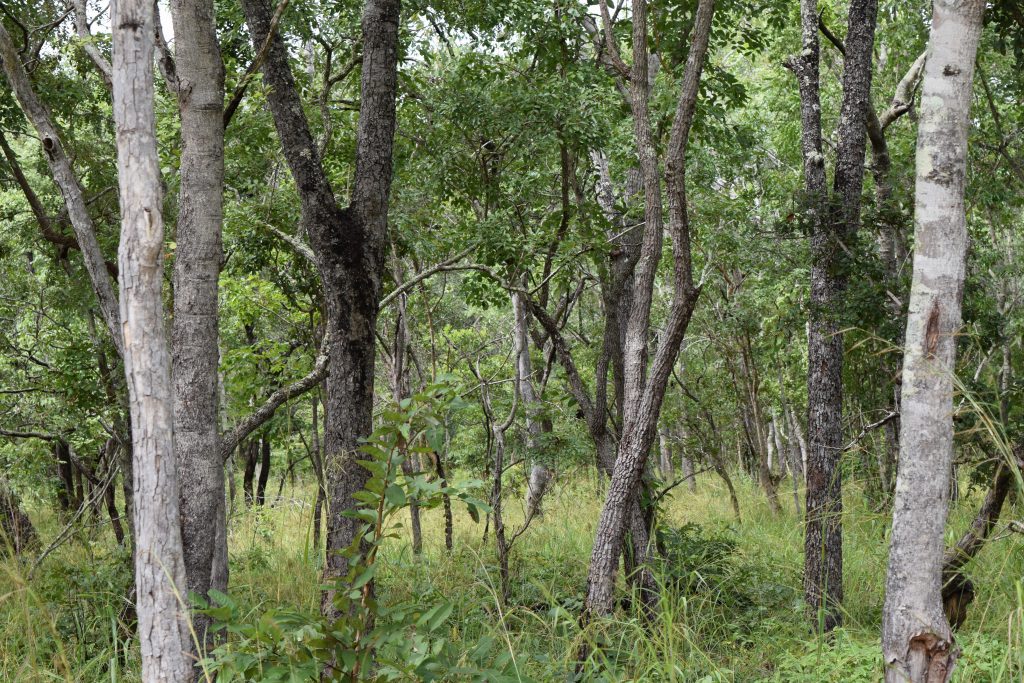 The Forest Justice in Tanzania initiative is a partnership project between the Tanzania Forest Conservation Group (TFCG) and the Community Forest Conservation Network of Tanzania (MJUMITA). FJT is a demand-driven process that reflects a growing call for change within the forest sector from Participatory Forest Management (PFM) stakeholders, including village governments, Members of Tanzania Forest Working Group, and Community Based Organizations (CBOs) established by villages participating in Community Based Forest Management (CBFM) in Tanzania.
The Forest Justice in Tanzania initiative is a partnership project between the Tanzania Forest Conservation Group (TFCG) and the Community Forest Conservation Network of Tanzania (MJUMITA). FJT is a demand-driven process that reflects a growing call for change within the forest sector from Participatory Forest Management (PFM) stakeholders, including village governments, Members of Tanzania Forest Working Group, and Community Based Organizations (CBOs) established by villages participating in Community Based Forest Management (CBFM) in Tanzania.
Phase 1 of the project was implemented between 2011 and 2015, and phase two will be implemented for the period of 24 months, 2020 to 2021. The project is funded by the UK’s Department for International Development (DfID) through Accountability in Tanzania phase 2 (AcT 2) program, managed by KPMG.
What Happened during FJT Project Phase 1
The first phase of the FJT project (FJT1) was implemented in 6 MJUMITA zones, 30 districts, and 13 regions and reached 10,370 members of 110 Community Based Organization (CBOs). The project benefited 451 PFM villages, with a population of about 1,029,000 men and women. The following were some of the success of the FJT 1 project:
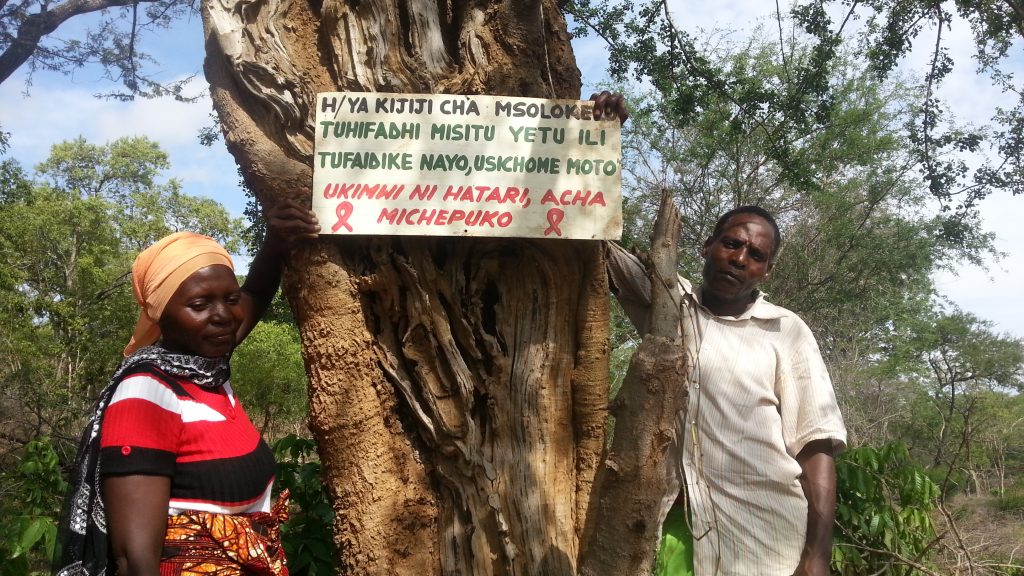
- A total of 904 (452 women and 452 men) community members, 12,250 members of Village Natural Resource committees (VNRCs), and village councils were acquainted with skills to undertake village forest governance monitoring process. About 400 villages implementing PFM were empowered on the use forest governance dashboard tool to address village governance shortfalls and increased the accountability in village governments;
- Forest Conditions for 6 forest reserves with high biodiversity hotspot i.e. Chome Nature Forest Reserve, Rondo Nature Reserve, Pugu, Kazimzumbwi, Ruvu South, and Udzungwa Scarp Forest Reserves; were monitored and assessed. The results from these interventions were shared publicly through media and stakeholder meetings, which lead decisions to improve the management effectiveness of these forest ecosystems;
- Supported MJUMITA networks (CBOs) and CBFM villages to address a total of 101 forest crimes through legal systems. There was a steady increase in the percentage of reported forest crimes that reach the courts of law over the lifetime of the project, from 0% in year 1 to 16.1% in the last 6 months of 2014;
A total of 300 community members from 6 MJUMITA zones were trained on forests products certifications and REDD+ standards. This increased their understanding in the management of natural forests, for improved management effectiveness in Managing Village Land Forest Reserves
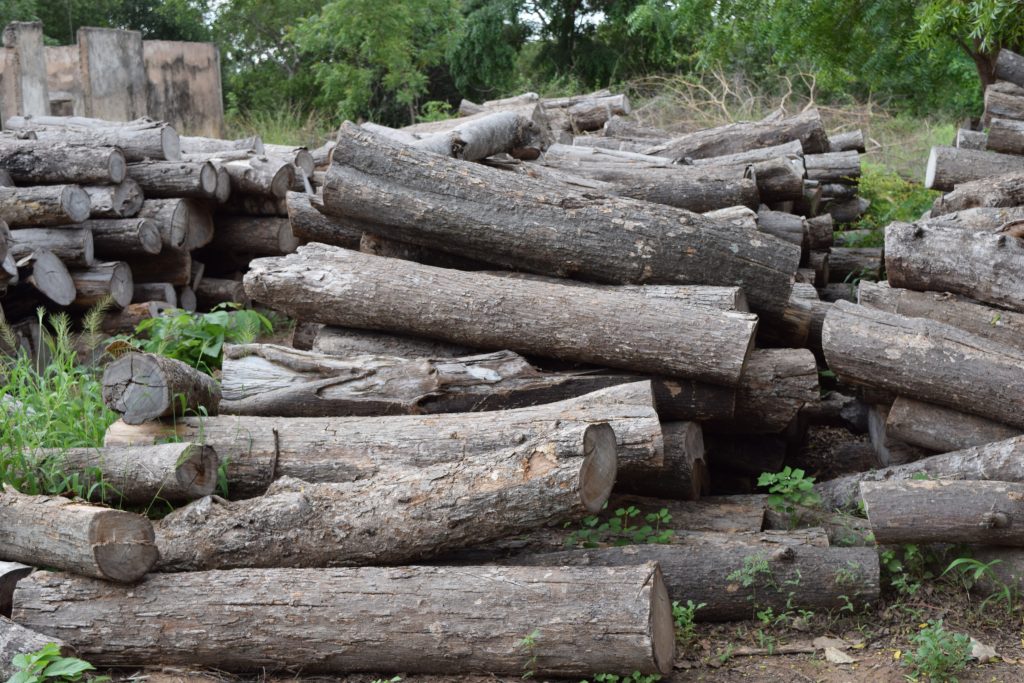
Why Forest Justice in Tanzania Project Phase 2 (FJT2)?
Forest Justice in Tanzania Project phase 2 was driven by the existing challenges facing the forest sector in Tanzania specifically the unreserved forests within the village land. Some of the challenges to be addressed by the project are as follows:
- More than 17.6 million hectares of forest cover which is equivalent to 80% of forests found in the village land are not legally reserved;
- More than 469,000 hectares of forests are cleared every year in Tanzania with most deforestation occurring on unreserved forests within the village land, mostly due to small-scale, slash-and-burn agriculture and illegal/unsustainable harvesting of forest product;
- New government regulations attempting to recentralize control of decisions on forest-based enterprises in the Village land Forest Reserves (VLFRs). For example, the GN 417 of 24th, May 2019 has a recentralized decision on the preparation of harvesting plan and approval of buyers of forest products from VLFRs. This is disincentivizing communities to conserve more forests on the village land.
FJT 2 Change trajectory
Based on the combined experience of TFCG and MJUMITA, FJT seeks to transform the trajectory of the forestry sector towards a more just vision that safeguards forest values while benefiting rural communities. The theory of how to deliver that change starts with catalysing a groundswell of community demand for CBFM by generating and communicating evidence about the benefits of CBFM and the scale and impact of deforestation; and by garnering widespread support for a vision of forest management in which every village in Tanzania has a community forest under its management. Working closely with Central and Local Government we seek to transform that vision into reality financed by the Government and with international climate financing; and by tackling current policy and practice barriers to community-based forest management (CBFM). The theory of Change is summarized in the following trajectory.
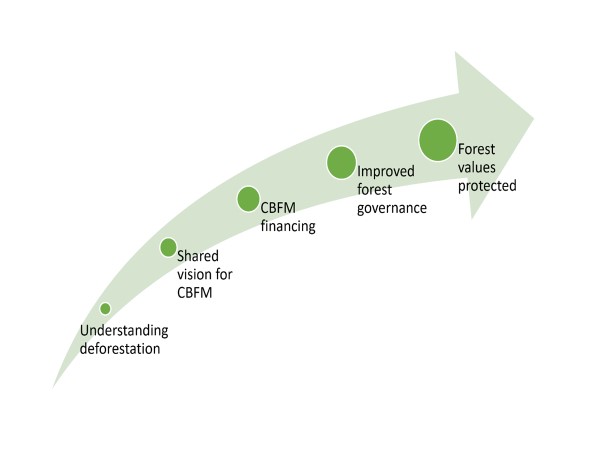
FJT 2 Project Goal
The goal of FJT2 project is to increase the accountability and responsiveness of central and local governments to protect the climate and other ecological services that natural forests provide to Tanzanian citizens.
How will Forest Justice in Tanzania (FJT 2 Project) achieve its desired objectives?
The project will achieve its goal under three big changes:
Change 1: More communities in Tanzania have more power to manage and benefit from their natural forest;
Activities to be implemented under change 1:
- Building the capacity of at least 1,000 community leaders from at least 30 MJUMITA local networks covering at least 100 villages, on scaling up CBFM, forest governance, advocacy, and gender;
- Support at least 30 local Community Based Organisations (CBOs) covering at least 100 villages to develop and implement advocacy strategies and action plans to advocate for scaling up CBFM and promoting good governance in the management of forests within the village land;
- To support villages implementing the CBFM program to address forest crimes through the legal systems.
Change 2: International Climate Finance and investment by the government is reaching communities involved in protecting forests found in the village land;
Activities to be implemented under change 2:
- To conduct a study on climate financing options for CBFM in Tanzania and present the findings to stakeholders including senior government officials;
- To develop at least two projects proposals worth about 3 USSD for supporting the government of Tanzania to address deforestation through CBFM approach;
- To engage media and attending UNFCCC-CoP to advocate for International Climate Finance to support CBFM in Tanzania.
Change 3: Deforestation in 3 nationally and internationally important forests is addressed;
Activities to be implemented under change 3:
- To work closely with Tanzania Forest Service and other stakeholders to study the drivers of deforestation in Mkingu Nature Forest Reserve, Chome Nature Forest Reserve, Udzungwa Scarp as well as Village Land Forest Reserves;
- To facilitate stakeholders meeting to raise awareness on issues affecting 3 national forest reserves and agree on the strategies to address those issues;
- To support villages and other stakeholders to participate in developing national CBFM strategy.
Project boundary Partners
For the project to achieve its goals, it aimed to work with the following boundary partners
- President’s Office-Regional Administration and Local Government and Local Government Authorities;
- Forest and Beekeeping Division (FBD), and Tanzania Forest Service (TFS);
- Elected leaders i.e. Member of parliaments and ward councilors
- Village councils
The project will also work with different strategic partners including media, law enforcement institutions, local and national auditors, courts of law, and other oversight authorities.
Where will the project operate?
The project will operate from village to national levels, but more specific activities will be implemented in three MJUMITA zones as follows
| S/N | Zone | Field Office Location | Regions and Districts to be involved | Mobile contact numbers |
| 1 | Northern Zone | Korogwe town | Tanga Region- Mkinga, Muheza, Korogwe, Handeni, Kilindi, and Bumbuli districts; | Zonal coordinator 0768636735
Assistant Zonal Coordinator 0784812158 |
| 2 | Southern Highland Zone | Iringa town | Iringa Region- Iringa, Kilolo and Mufindi districts; | Zonal coordinator 0754257247
Assistant Zonal Coordinator 073720 4424 |
| 3 | Southern Zone | Kilwa Masoko | Coastal region- (Rufiji district), Lindi Region- (Liwale, Mtama, Nachingwea, and Kilwa) and Ruvuma- (Tunduru district). | Zonal coordinator 0752566586; Assistant Zonal Coordinator 0654898154 |
Linkage Between FJT2 and Sustainable development Goals.
By contributing to Sustainable Forest Management, FJT2 is contributing to 10 out of 17 Sustainable Development Goals
Linkages between FJT 2 and the TFCG and MJUMITA 5-year Strategic Plans
TFCG. 2018. Strategic Plan 2018 – 2022.
http://mjumita.org/?s=MJUMITA+strategic+plan
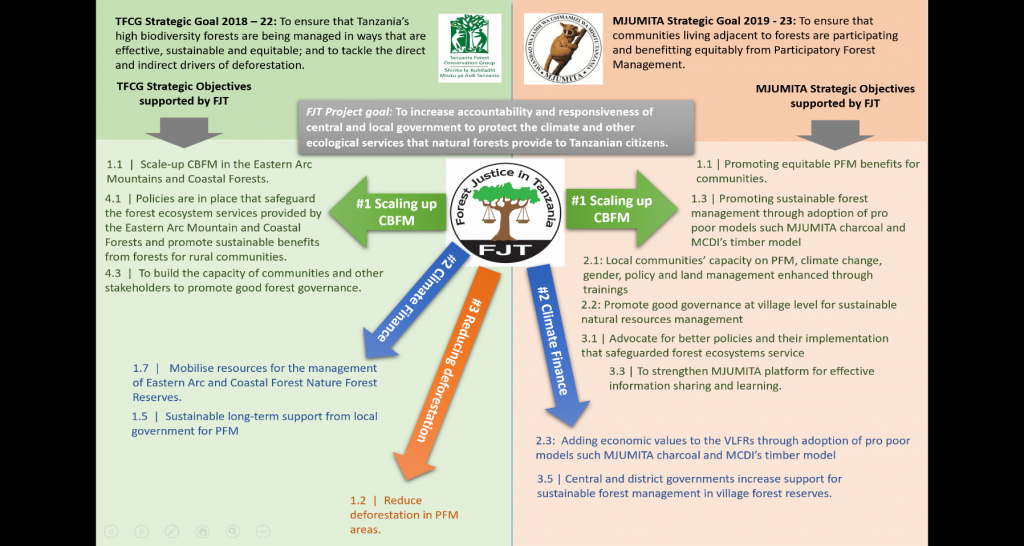
Linkages between FJT and the CoForEST Project
FJT 2 Project Implementing Partners
Tanzania Forest Conservation Group (TFCG)
TFCG is a national non-governmental organization whose mission is to conserve and restore the biodiversity of globally important forests in Tanzania. TFCG is the lead partner in the implementation of FJT Project
For detail about TFCG
Website: www.tfcg.org
Email: tfcg@tfcg.or.tz
Tanzania Community Forest Conservation Network (MJUMITA)
The Mtandao wa Jamii wa Usimamizi wa Misitu Tanzania (MJUMITA) in English also known as The Community Forest Conservation Network of Tanzania is a network of local community-based organizations (CBOs) involved in Participatory Forest Management (PFM) in Tanzania. MJUMITA currently has 117 affiliated local area networks (also known as CBOs), which are made up of Village Natural Resource Committees (VNRCs), Environmental/Forest User Groups, beekeeping groups and charcoal makers founds in 13 regions, 30 districts and 450 villages involving 500 CBOs with more than 10,000 members
For more detail about MJUMITA:
Website: www.mjumita.org
FJT 2 – Forest Campaign 2020
Forest Justice in Tanzania 2- Forest Campaign for all villages-Eng.pdf
Forest Justice in Tanzania 2- Forest Campaign for all Villages-Swahili.pdf
FJT 2 Briefs about the project
Forest Justice in Tanzania- FJT-BRIEF-SWAHILI-leaflet. pdf
Forest Justice in Tanzania- FJT 2 BRIEF ENGLISH leaflet .pdf
FJT 2 Posters
Forest Justice in Tanzania- TFCG-POSTERS Booklet.pdf
Improving governance in Tanzania’s forestry sector 2011-2013
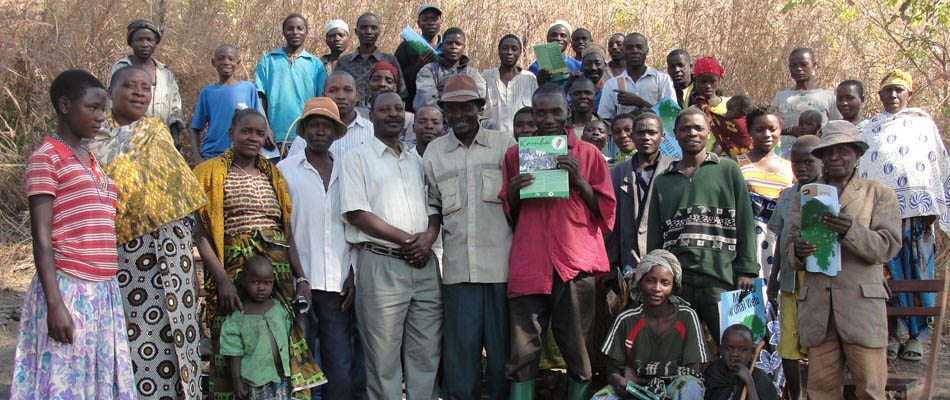
Forest Justice in Tanzania
Aims and objectivesForest Justice in Tanzania aims to promote good governance and improved accountability in the forestry sector in Tanzania. The initiative is a partnership between the Community Forest Conservation Network of Tanzania, known as MJUMITA and the Tanzania Forest Conservation Group. The project is funded through the Accountability in Tanzania (AcT) programme and will operate from 2011 – 2013. The objectives are that• Governance within the forestry sector is improved. • Tanzanian citizens benefit from forest ecosystem services. Immediate outcomes• Effective and sustained citizen demand for improved forest management and governance. • Government leaders at all levels support effective forest management. How will Forest Justice in Tanzania achieve its objectives? |
||
The project will work through four inter-related strategies.
Strategy 1:Monitoring forest governance and forest condition.The project will monitor forest governance and forest condition with a view to demonstrating the issues that contribute to the loss of Tanzania’s forest values and to provide a benchmark for improvement in forest governance. Strategy 2:Enforcement promotionThis strategy aims to encourage Central and Local Government to become more proactive in addressing forest crimes as well as building the capacity of community members to take action against governance shortfalls within the forest sector. Strategy 3:Research, analysis and communication.The project will carry out research and analysis in order to determine where the obstacles lie to achieving improved forest management and forest governance. |
Strategy 4:Agreeing standards.The project will work to promote best practices within the forestry sector. This will include promoting the National REDD standards and the National Forest Stewardship Council standards. Where will the project operate?Whilst some aspects of the project will operate at a national level, field-level activities in relation to governance monitoring and enforcement promotion will take place in the six zones that apply to MJUMITA networks: Eastern Zone – Morogoro, Pwani, and Dar es Salaam Regions Northern Zone – Tanga, Kilimanjaro and Arusha Regions Southern Zone – Lindi, Mtwara and Ruvuma Regions Southern Highlands Zone – Iringa Region Central Zone – Manyara, Dodoma, and Singida Regions Western Zone – Kigoma Region |
|
Is enough being invested in forestry in Tanzania?Insufficient government investment in forest management is frequently cited as a reason for forest loss in Tanzania. The Forest Justice in Tanzania project aims to bring this issue into the public spotlight and to advocate for more efficient and effective investment by the Government in the management of the forests entrusted to its care. Details on current and historic government budgets in the forestry sector have been collated and can be downloaded here. URT 2007. Subvote 3001. Forestry and Beekeeping Division. Ministry of Natural Resources and Tourism. Volume II. Estimates of Public Expenditure. Consolidated Fund Services (Section 1). Supply Votes (Ministerial). 2007 – 2008. URT 2008. Subvote 3001. Forestry and Beekeeping Division. Ministry of Natural Resources and Tourism. Volume II. Estimates of Public Expenditure. Consolidated Fund Services (Section 1). Supply Votes (Ministerial). 2008 – 2009. URT 2009. Subvote 3001. Forestry and Beekeeping Division. Ministry of Natural Resources and Tourism. Volume II. Estimates of Public Expenditure. Consolidated Fund Services (Section 1). Supply Votes (Ministerial). 2009 – 2010. URT 2011. Subvote 3001. Forestry and Beekeeping Division. Ministry of Natural Resources and Tourism. Volume II. Estimates of Public Expenditure. Consolidated Fund Services (Section 1). Supply Votes (Ministerial). 2011 – 2012. Publications and ReportsTFCG, 2015. An analysis of the ecological and financial sustainability of natural forest management in Tanzania. MJUMITA and TFCG, 2015. Maazimio ya Wananchi kwa vyama vya siasa kuhusu uhifadhi wa misitu na mazingira: uchaguzi wa 2015. eMJee, 2015. External evaluation of the Forest Justice in Tanzania Project 2011 – 2014. MJUMITA and TFCG. 2014. Policy Brief: Monitoring village forest governance with the MJUMITA dashboard tool. 4 pp Aklei, A. and E. Monga 2014. Are district officials playing their part in providing forest justice in Tanzania? A report on a survey of forest governance at District level. Forest Justice in Tanzania Technical Report. Albert, A. 2014. Monitoring changes in forest governance at village level in Tanzania between 2011 and 2013. MJUMITA and TFCG pp. 1-60. pdf 967 kb Gwegime, J., J. Latham, M. Mwangoka, E. Mulungu, J. Kitenana, R.Mwakisoma, R.E. Gereau and N. Doggart (2014). The biodiversity and forest condition of Chome Nature Reserve. TFCG Technical Paper 42. TFCG, DSM, Tz. 1-77 pp. 6 MB Gwegime, J., M. Mwangoka, E. Mulungu, J. Latham, R.E. Gereau and N. Doggart (2014). The biodiversity and forest condition of Mamiwa-Kisara North Forest Reserve. TFCG Technical Paper 41. TFCG, DSM, Tz. 1-86 pp. 2.5 MB Gwegime, J., M. Mwangoka, E. Mulungu, H. Said, J. E. Latham, R. E. Gereau and N. Doggart, (2014). Two surveys of the biodiversity and forest condition of Rondo Proposed Nature Reserve in 2012 and 2013. TFCG Technical Paper 39. TFCG. DSM, Tz. 1-77. 4 MB Gwegime, J., Mwangoka, M., Mulungu, E., Perkin A. and K. Nowak (2013). The biodiversity and forest condition of Ruvu South Forest Reserve. TFCG Technical Paper 37. pdf 1.4 MB Gwegime, J. Y., Mwangoka, M., Said, H.. Mulungu, E., Nowak, K. and N.Doggart, 2013. Two surveys of the plants, birds and forest condition of Pugu and Kazimzumbwi Forest Reserves in 2011 and 2012. TFCG Technical Paper 36. Pp 1 – 137. pdf 2.5 MB. Fundi, E. 2012. Community dashboard governance monitoring report. MJUMITA. MJUMITA 2012. Community advocacy in the forestry sector:A study of advocacy options for communities to address forest management issues. 662 KB MJUMITA and TFCG 2012. Training of trainers manual for the implementation of the community forest governance dashboard. pp 1 – 20. 650 KB MJUMITA and TFCG 2012. Kiongozi kwa Watumiaji wa Dodoso la Ufuatiliaji Utawala Bora katika sekta ya misitu. pp 1 – 27. 950 KB TFCG and MJUMITA 2012. At current rates of deforestation some national forest reserves will have no forest in them by 2017: is enough being invested in forest management to prevent this? Policy Brief. TFCG na MJUMITA 2011. Katika Kutafuta Usimamizi wa Pamoja wa Misitu Tanzania… Muhtasari wa Kisera. TFCG and MJUMITA 2011. Forest Justice in Tanzania. Project Leaflet – English. TFCG and MJUMITA 2011. Forest Justice in Tanzania. Project Leaflet – Swahili. TFCG and MJUMITA 2011. Recommendations for the revised National Forest Policy. TFCG 2011. Forest Justice in Tanzania. Arc Journal 26. Documents for commentZilihona, I. 2012. Tanzania Forest Fund: Guidelines for preparation of project proposals and procedures for making grants. Draft Reports. Project Progress SummariesForest Justice in Tanzania. Progress Summary July to December 2011. 2 MB Forest Justice in Tanzania. Progress Summary 2012. |

